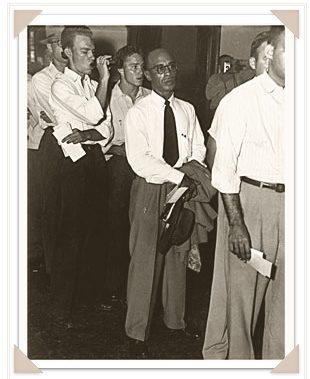Here is a photo of the eponymous plaintiff in Sweatt v. Painter.
Sweatt’s family actually filed an amicus brief in Fisher v. Texas. From the statement of interests:
Amici curiae are the daughter and nephews of Heman Marion Sweatt, who in 1946 was denied admission to The University of Texas Law School for one reason: “the fact that he is a negro.” Texas law forbade UT from considering any of his other qualities: not his intelligence, not his determination, not the grit he gained living under and fighting Jim Crow.
In 1950 – four years before Brown v. Board of Education – this Court held that Sweatt must be admitted to UT, because the separate law school created to accommodate him was not equal in – among other things – intangibles such as reputation and because Sweatt would be “removed from the interplay of ideas and the exchange of views” with “members of the racial groups which number 85% of the population of the State.”
Today, UT honors the legacy of Heman Sweatt in many ways, none more important than its commitment to creating a genuinely diverse student body. It does so through an admissions policy that considers (to the extent allowed by the Texas Top Ten Percent Law, which depends on secondary-school segregation to increase minority enrollment) all aspects of an applicant’s character – including, in part, how that character has been shaped by race.
There is a certain irony that the last time the University of Texas argued in the Supreme Court about an admissions policy, they sought to exclude Sweatt, an African-American applicant. The Supreme Court said that this was not allowed. This time around, they are seeking to include African-American applicants. The Supreme Court may also say this is not allowed.
